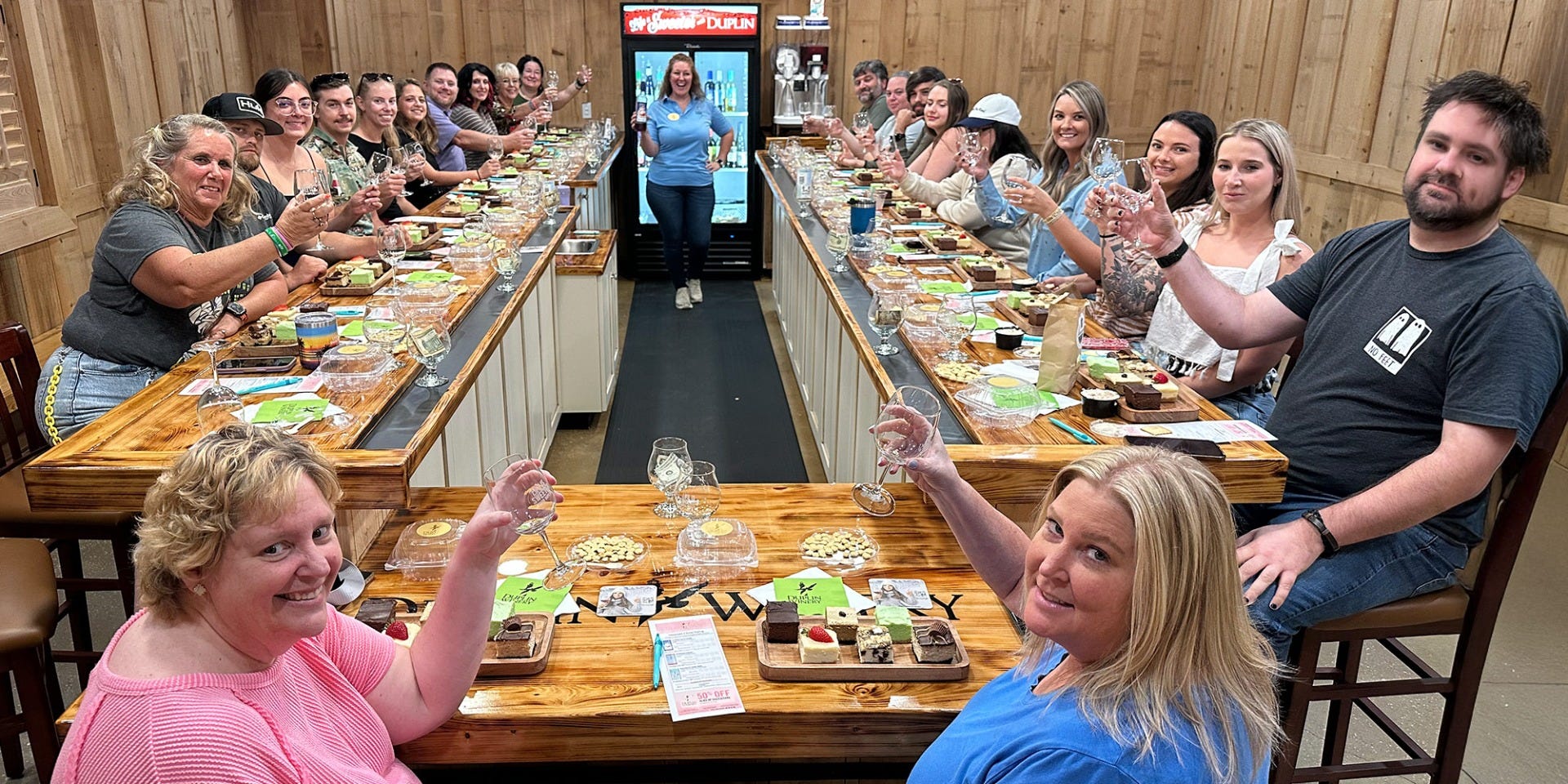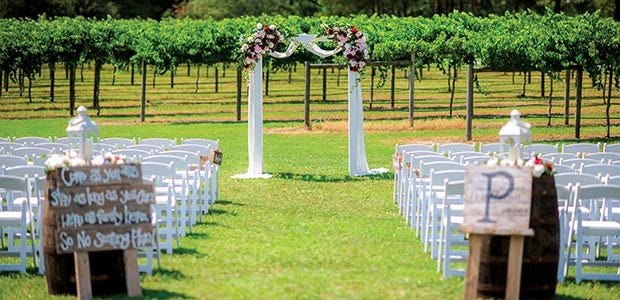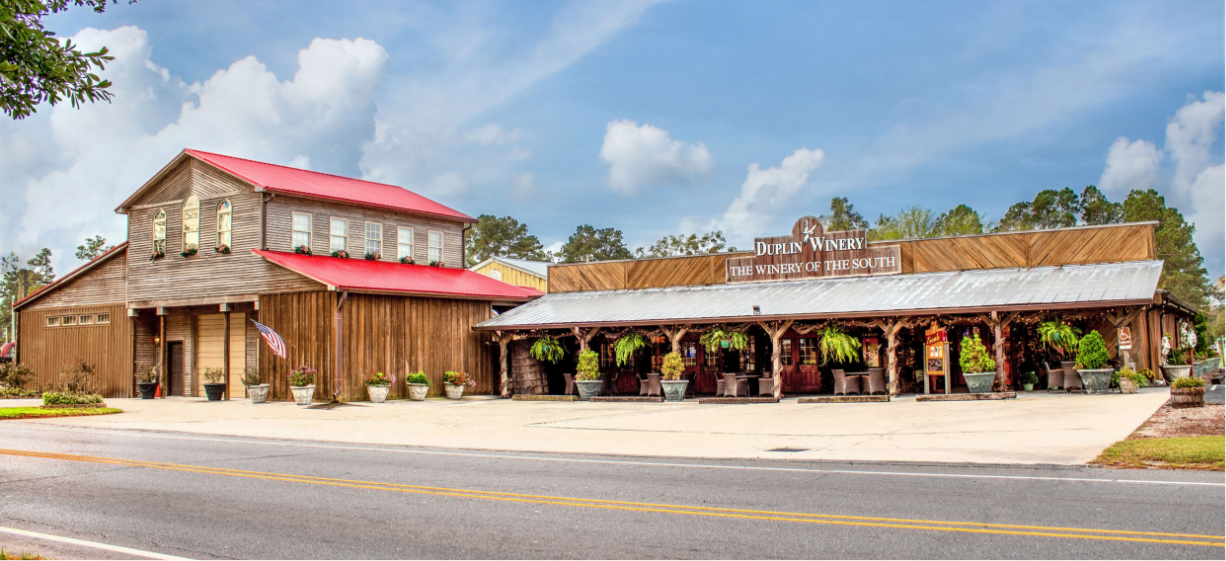This at home wine tasting kit has everything you need for a virtual wine tasting
Relax at home or gather friends and family on Zoom for a virtual wine tasting that will make you feel like you're right there in our Rose Hill or North Myrtle Beach tasting rooms.
Duplin At Home Wine Tasting Kits include many of the same wines we serve in our tasting rooms. Our newest kit includes wildly popular, limited-run Queen Anne's Revenge, a red inspired by famous pirate Blackbeard's flagship. Plus, there's always Duplin Muscadine Pineapple Habanero Salsa so that you can whip up our famous cheese dip. We popped in a bag of homemade Duplin Gourmet crackers, too.
Also, find a Sip & Savor Wine Tasting Score Card you can use to keep notes and rate the wines. If you're hosting a group, fellow tasters may download score cards right onto their mobile devices or you may print out extra copies via the link below.
If you've already purchased the kit, get your tasting started now with the video above. Follow along as top Duplin bartender, Nolan guides you through each wine. Scroll down this blog post to find more tasting notes.
Don't have our newest Sip & Savor At Home Wine Tasting Kit? Don't worry. You can add directly to your cart from this page! Our Spring 2020 virtual wine tasting kit is still available, too.
Every at-home wine tasting kit also includes easy recipes for both our popular Muscadine Pineapple Habanero cheese dip and Muscadine Red Pepper & Onion Relish cheese dip. Make cheese dip and set it out with crackers before starting your wine tasting. Nibbles help cleanse your palate as you're trying wines.
How to taste wine like a Duplin pro
See. Swirl. Sniff. Sip. Savor. Use this 5-step system for each wine on the 2020 Summer Tasting Sheet included in your kit. Here's how.
See: First, hold a wine up to a light and look at the color. It will allude to the variety of grape used and what the wine will taste like. Is it Scuppernong? Nobel? Carlos? Another? Color also indicates flavor. A bright, saturated hue often means more intense flavor. See if you can guess the grape and flavor before you sip.
Swirl: Consider the wine's body next. Swirl the wine in your glass to determine if it is light or heavy. You're looking for the viscous streaks running down the side of the glass after you swirl. They're called "legs." Sweeter wines will leave streaks cling or move slowly. That means a heavier body.
Sniff: After you swirl, really dip your nose into the glass and inhale the aroma, what wine pros call the "bouquet" or "nose." Pausing to experience the bouquet heightens your senses and anticipation of the first sip. Think about what you are smelling. Is it fruity? What kind of fruit? Berries? Ripe banana? Musky honeydew melon? Pure grape? Are you getting floral notes like honeysuckle or gardenia? See if you pick up unexpected smells like pine or fall leaves. Describe the bouquet and discuss it.
Sip: Take a sip slightly larger than normal and hold the wine in your mouth for 3-5 seconds. Let the wine coat the tongue and the inside of your mouth. Wine releases more flavors as it warms on your taste buds. Before swallowing, purse your lips and breathe in gently, allowing the air to travel across the wine in your mouth to get the full flavor profile.
Do the flavors you're experiencing match the wine's nose? When and where are you tasting those flavors? Are you getting, say, banana bread on the first sip and then astringency or acidity at the end, which is called "the finish." Where do flavors hit you? On the tongue? On the side of your mouth.
Think back to the wine's body. Compare the texture of different wines, how they feel in your mouth. Light as water or heavier, like the texture of sweet iced tea? If you're sampling a sparkling wine, do the bubbles feel fine or medium in size. Compare your experience to the wine's description and see if it matches.
Savor: As you continue sipping, note how the sensation is slightly different from what you experienced when the wine was resting in your mouth on the first sip. This is the point when you taste and feel the wine's finish. As you continue tasting, note how the wine pairs with the Duplin Gourmet crackers and Muscadine Pineapple Habenero dip. See which wine you like best with those snacks and others you may be enjoying during your at-home or virtual tasting. Cheers!
Now, let's begin our wine tasting!


Carlos
Released in 1976, Carlos is one of Duplin’s first wines. Soft, dry and fruity, it might remind you of pinot grigio or unoaked chardonnay. For this wine, Duplin picks Carlos grapes early, before they ripen too much and become sugary. With a 1.5% sugar level, Carlos is one of the driest Duplin wines. Both wine and grape are named after Carlos Williams, a N.C. State University professor who in the mid-1900s was key to developing muscadine grape varieties for winemaking.


Magnolia
Williams and his team also developed the namesake grape in Magnolia. The grape is named after Williams’ hometown, Magnolia, N.C. This semi-sweet, fruity wine in 1989 earned Duplin its first international prize. In 2006, Martha Stewart Living magazine billed it one of summer’s best wines. Note the medium body, sweet start and clean finish. Magnolia might remind you of riesling. It pairs really well with spicy foods.


Mothervine Scuppernong
New World explorers of the 1500s couldn’t believe so many wild grapes grew along the shore of what would become North Carolina. That same century, someone on Roanoke Island planted what has been named the Mothervine, a Scuppernong thought to be America’s first cultivated grapevine. Duplin acquired cuttings from the nearly 450-year-old vine in the early 2000s and released this sweet, fruity wine in 2008. It tastes like the grape itself. The wine’s sugar level is 10.5%, so take time to compare the sweetness level to Carlos, the first wine in this tasting lineup. With just one vineyard of Mothervine grapes, Duplin releases a limited amount of this wine.


Brice’s Creek
Wine No. 4 in this tasting is named after a tiny community near New Bern, N.C., where still waters running through pine forests are calming and peaceful. Take time to notice the slight floral start. Do you sense jasmine? Yellow jessamine? Pay attention to the smooth finish and light alcohol bite. This wine’s complexity is thanks to a combination of Scuppernong and Niagara grapes. Niagara is not muscadine but a Native American vitis labrusca variety developed in Niagara County, N.Y. Notice how the wine differs from the all-Scuppernong Mothervine wine you just tasted.


Burgundy
This lineup’s 5th wine has a 1.5% sugar level, similar to the sugar content in merlot or cabernet sauvignon. Duplin Burgundy is much lighter and fruitier than those wines. Duplin winemakers use a blend of early-harvest muscadine grapes. You may remember from the earlier discussion of Carlos that grapes picked before they become too ripe are less sweet. Sip slowly. This wine packs 13% alcohol, making it a great partner to a big steak or caramelized onion and mushroom burger.


Pelican Red
Wine No. 6 is another blend. This one combines mid-harvest muscadines, which have developed a bit more sugar than those early-harvest grapes in Carlos, with interesting Pink Catawba grapes. Catawbas are a cross between vitis labrusca (the grape family that includes the Niagara in that Brice’s Creek wine you just tried) and the European cultivar Semillon. Native to France, Semillon is a golden, thin-skinned grape used in sweet and dry wines. Historians aren’t sure who first crossed these two grapes, but early vines were said to have grown on a so-called “Rose Hill property” in Maryland. Rose Hill is also the name of the N.C. town where Duplin Winery was founded. Pink Catawba grapes showed up in the 1940s in upstate New York. With just 7% sugar, Pelican Red is mid-sweet with a smooth floral finish.


Queen Anne's Revenge
Blackbeard, the scourge of the Carolina shores, was a scoundrel of the highest order. You can almost hear the mighty timbers of his flagship Queen Anne’s Revenge’s, creaking and cracking as you pour a glass of our complexly sweet, slightly tart Queen Anne’s Revenge red wine. This bold-bodied wine, with a bite at the end, is made with the muscadine grape variety Nobel. The wine shows up only once a year because of the special process used to make it. Grapes are fermented on the skins in outdoor tanks exposed to Mother Nature’s irregular temperatures. Those temperature shifts add to the wine’s complexity. We celebrated QAR’s 2020 arrival with a new label that shows the legendary ship whispering toward fiery red Hatteras shores.


Sangria Rosé
The 8th wine is one Duplin fans have billed “God Bless America.” So many people asked Duplin bartenders to blend Sangria White and Sangria Red in a single glass that Duplin winemakers decided to create Sangria Rose in 2019. Cool, sweet and easy, the blend of red and white muscadines is infused with citrus. See if you can also pick up peach, mango and berry notes.


Sweet Poppy
Fun, fizzy and blooming with a hint of peach, No. 9 on this tasting is the 2020 release Sweet Poppy. The first sip is full of harmonious fruity flavors followed by a satisfyingly fizzy finish. How do you think the bubbles affect the flavor of the wine? Also, ponder the story behind that beautiful red flower on the bottle. Red corn poppies have long been a symbolic tribute to our troops. Duplin put a red corn poppy on the wine’s label to honor service members, past and present.


Raspberry Mango Lemonade
Duplin wine slushies are called Sweetzers, and you can make them at home with a blender. This flavor’s mix of sweet raspberries, distinctive mango and zippy lemon makes a sweet-tart frozen delight when whizzed with ice and the soft Brice’s Creek you sampled earlier in this tasting. Sweetzers are great refreshers for ending any wine tasting.
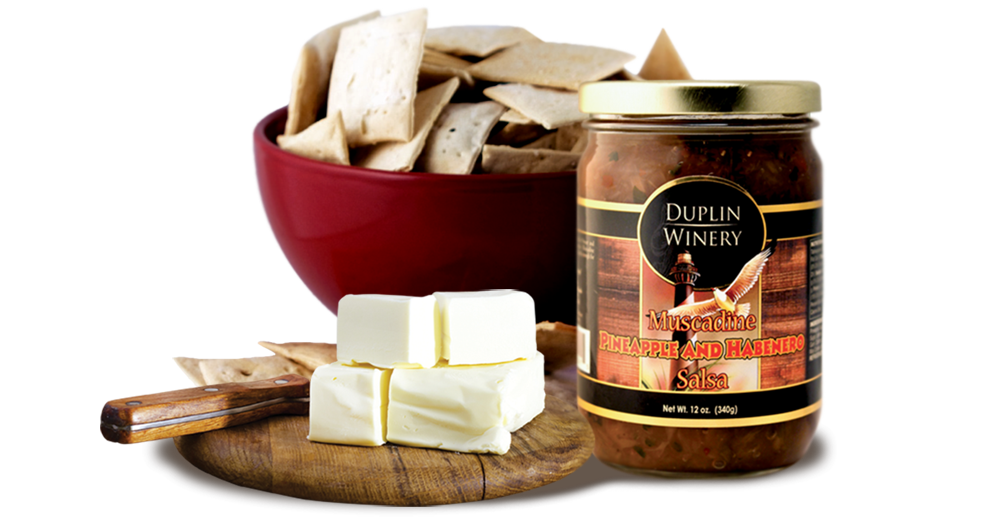

Muscadine Pineapple Habanero Dip
Our Muscadine Pineapple Habanero Dip pairs perfectly with our wine tastings. Between wines, eat a few crackers with the dip to help cleanse your palate. This tasty recipe is super easy to make and even better to eat!
To make: soften one 8-ounce block of cream cheese and mix in ½ a jar of Duplin Muscadine Pineapple & Habanero Salsa. Use a hand mixer to blend together until the consistency is creamy. Serve with Duplin Gourmet Crackers.
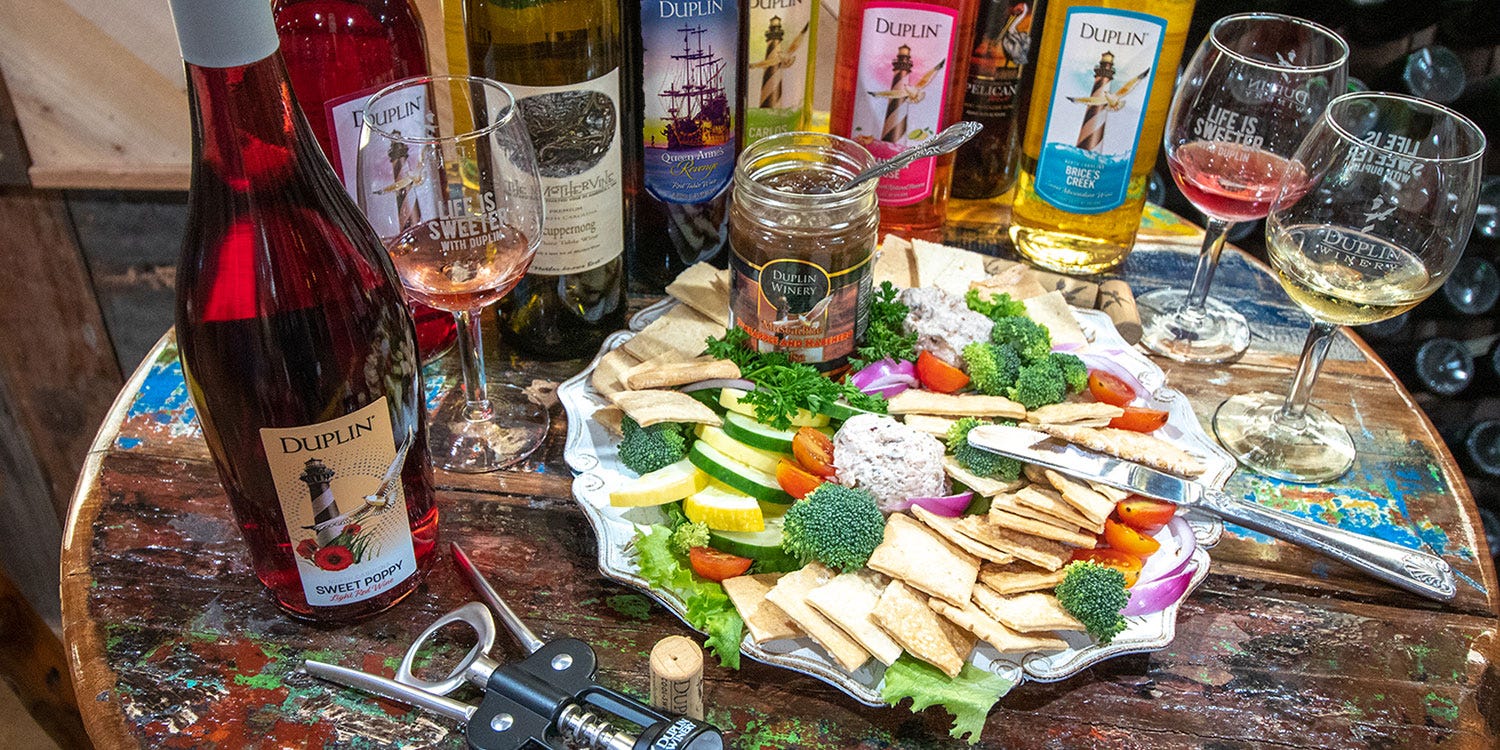 ?>
?>



